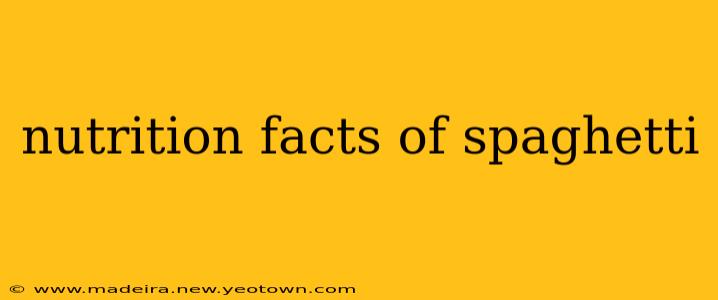Unraveling the Nutritional Secrets of Spaghetti: A Delicious Deep Dive
Spaghetti, that beloved culinary staple, has graced tables worldwide for centuries. But beyond its delightful taste and versatility, lies a nutritional profile worth exploring. This isn't just about calories; it's about understanding the role spaghetti plays in a balanced diet, and how to make the most of this pantry essential.
Let's embark on a journey to uncover the nutritional facts of spaghetti, addressing common questions along the way.
What are the basic nutritional facts of spaghetti?
A single cup (156g) of cooked spaghetti boasts approximately 200-220 calories. However, this number can fluctuate depending on the brand and whether it’s enriched or whole wheat. Enriched spaghetti is typically fortified with iron and B vitamins, boosting its nutritional value beyond just carbohydrates. The calorie count also reflects the fact that it's largely carbohydrates—providing energy for your body. It offers a moderate amount of protein, though it's not a primary protein source.
How much protein, carbohydrates, and fat is in a serving of spaghetti?
The macronutrient breakdown of cooked spaghetti is predominantly carbohydrates. You can expect roughly 40-45 grams of carbohydrates per cup, with 7-8 grams of protein and less than 1 gram of fat. This makes spaghetti a good source of readily available energy, especially important for active individuals.
Is spaghetti a good source of fiber?
The fiber content is where whole wheat spaghetti shines. While regular enriched spaghetti provides a modest amount of fiber, opting for whole wheat significantly increases this vital nutrient. Whole wheat spaghetti offers approximately 6-8 grams of fiber per cup, compared to roughly 2-3 grams in its enriched counterpart. This added fiber aids digestion, promotes gut health, and contributes to feelings of fullness.
Does spaghetti contain vitamins and minerals?
Yes, though the amounts vary depending on the type of spaghetti. Enriched spaghetti is fortified with iron and several B vitamins, including thiamin, riboflavin, and niacin. Whole wheat spaghetti, while naturally containing less of these fortified vitamins, often provides a wider range of other minerals and vitamins thanks to its higher fiber content.
What are the differences between enriched and whole wheat spaghetti?
The key difference lies in the processing of the wheat. Enriched spaghetti uses refined flour, resulting in a smoother texture and a slightly lower fiber content. The enrichment process adds back some of the nutrients lost during refining. Whole wheat spaghetti uses the entire wheat kernel, preserving more fiber, vitamins, and minerals. This results in a slightly coarser texture and a more substantial nutritional profile, offering significant benefits for digestive health and overall well-being.
How can I make spaghetti a healthier part of my diet?
Spaghetti doesn't have to be a dietary villain. Pairing it with plenty of vegetables, lean proteins (like chicken, fish, or lentils), and a flavorful, light sauce significantly enhances its nutritional value and creates a well-rounded meal. Consider using smaller portions of spaghetti and focusing on incorporating more nutrient-dense ingredients to maximize your dietary intake. Remember, moderation is key.
Can I eat spaghetti if I'm on a diet?
Absolutely! Spaghetti can be part of a balanced diet, even if you are watching your weight. Choosing whole wheat spaghetti, controlling portions, and pairing it with nutrient-rich additions ensures you get the benefits of this comforting food without compromising your dietary goals.
This exploration of spaghetti's nutritional facts illustrates that this staple food offers more than just simple carbohydrates. By making informed choices—choosing whole wheat when possible, controlling portion sizes, and mindful pairing with other nutritious foods—you can enjoy spaghetti as part of a healthy and balanced diet. Remember, balanced eating is about enjoyment and well-being, not strict exclusion!

